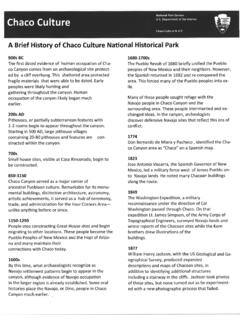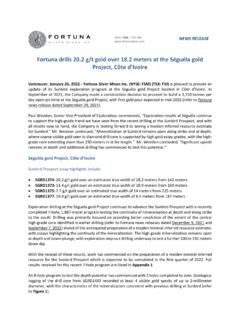Transcription of THE AMERICAN PAGEANT - Weebly
1 THEAMERICANPAGEANT2 PARTONEFOUNDING THENEWNATION c. 33,000 European explorers who followed ChristopherColumbus to North America inthe sixteenth century had nonotion of founding a new did the first Europeansettlers who peopled the thirteenEnglish colonies on the easternshores of the continent in the sev-enteenth and eighteenth cen-turies. These original colonistsmay have fled poverty or religiouspersecution in the Old World, butthey continued to view them-selves as Europeans, and as sub-jects of the English king. Theyregarded America as but thewestern rim of a transatlanticEuropean life in the New Worldmade the colonists different from their Europeancousins, and eventually, during the AMERICAN Revo-lution, the Americans came to embrace a vision oftheir country as an independentnation.
2 How did this epochaltransformation come about?How did the colonists overcomethe conflicts that divided them,unite against Britain, and declarethemselves at great cost to be an AMERICAN people?They had much in commonto begin with. Most were English-speaking. Most came determinedto create an agricultural societymodeled on English in the New Worlddeepened their common learned to live lives unfet-tered by the tyrannies of royalauthority, official religion, andsocial hierarchies that they hadleft behind. They grew to cherishideals that became synonymous with Americanlife reverence for individual liberty, self-govern-ment, religious tolerance, and economic opportu-3nity.
3 They also commonly displayed a willingness tosubjugate outsiders first Indians, who were nearlyannihilated through war and disease, and thenAfricans, who were brought in chains to serve asslave labor, especially on the tobacco, rice, andindigo plantations of the southern if the settlement experience gave people acommon stock of values, both good and bad, it alsodivided them. The thirteen colonies were quite dif-ferent from one another. Puritans carved tight,pious, and relatively democratic communities ofsmall family farms out of rocky-soiled New was a homogeneous world in comparison tomost of the southern colonies, where large land-holders, mostly Anglicans, built plantations alongthe coast from which they lorded over a labor forceof black slaves and looked down upon the poorwhite farmers who settled the backcountry.
4 Differ-ent still were the middle colonies stretching fromNew York to Delaware. There diversity reigned. Well-to-do merchants put their stamp on New York City,as Quakers did on Philadelphia, while out in thecountryside sprawling estates were interspersedwith modest homesteads. Within individualcolonies, conflicts festered over economic interests,ethnic rivalries, and religious practices. All thoseclashes made it difficult for colonists to imagine thatthey were a single people with a common destiny,much less that they ought to break free from AMERICAN colonists in fact had little reasonto complain about Brit-ain.
5 Each of the thir-teen colonies enjoyeda good deal of self-rule. Many colonistsprofited from tradewithin the BritishEmpire. But by the1760s, this stablearrangement began tocrumble, a victim ofthe imperial rivalrybetween France andBritain. Their strugglefor supremacy inNorth America beganin the late seventeenthcentury and finallydragged in the colonists during the French andIndian War from 1756 to 1763. That war in one sensestrengthened ties with Britain, since colonial mili-tias fought triumphantly alongside the British armyagainst their mutual French and Indian by driving the French from the North Americancontinent, the British made themselves less indis-pensable to the AMERICAN colonies.
6 More importantstill, after 1763 a financially overstretched Britishgovernment made the fateful choice of imposingtaxes on colonies that had been accustomed toanswering mainly to their own colonial the 1770s issues of taxation, self-rule, and traderestrictions brought the crisis of imperial authorityto a head. Although as late as 1775 most people inthe colonies clung to the hope of some kind ofaccommodation short of outright independence,royal intransigence soon thrust the colonists into awar of independence that neither antagonist couldhave anticipated just a few years years of revolutionary war did more thananything in the colonial past to bring Americanstogether as a nation.
7 Comradeship in arms and thestruggle to shape a national government forcedAmericans to subdue their differences as best theycould. But the spirit of national unity was hardlyuniversal. One in five colonists sided with theBritish as Loyalists, and a generation would passbefore the wounds of this first AMERICAN civil war fully healed. Yet in the end, Americans won the Rev-olution, with no smallmeasure of help fromthe French, because inevery colony peopleshared a firm beliefthat they were fightingfor the unalienablerights of life, liberty,and the pursuit ofhappiness, in thewords of Thomas Jef-ferson s magnificentDeclaration of Inde-pendence.
8 Almost twohundred years of liv-ing a new life had pre-pared Americans tofound a new World Beginnings 33,000 have come to believe that this is a mighty continent which was hitherto Your Highnesses have an Other World , 1498 Several billion years ago, that whirling speck ofdust known as the earth, fifth in size among theplanets, came into six thousand years ago only a minuteago in geological time recorded history of theWestern world began. Certain peoples of the MiddleEast, developing a primitive culture, graduallyemerged from the haze of the hundred years ago only a few seconds inthe past, figuratively speaking European explorersstumbled on the AMERICAN continents.
9 This dra-matic accident forever altered the future of both 4 RECORDEDHISTORYBEGINSJESUSBORNVIRGINIAFO UNDEDBICEN-TENNIAL4000 8 'SDISCOVERYVIRGINIAFOUNDEDINDEPENDENCEDE CLAREDWORLD WAR I IENDS46 years9 yearsCOLDWARENDSNEWMILLENNIUMBEGINS14921 60717761991 20001945115 years169 years169 yearsthe Old World and the New, and of Africa and Asia as Shaping of North AmericaPlanet earth took on its present form slowly. Some225 million years ago, a single supercontinent con-tained all the world s dry land. Then enormouschunks of terrain began to drift away from thiscolossal continent, opening the Atlantic and IndianOceans, narrowing the Pacific Ocean, and formingthe great landmasses of Eurasia, Africa, Australia,Antarctica, and the Americas.
10 The existence of a sin-gle original continent has been proved in part by thediscovery of nearly identical species of fish thatswim today in the long-separated freshwater lakesof the various shifting and folding of the earth scrust thrust up mountain ranges. The Appalachianswere probably formed even before continental sepa-ration, perhaps 350 million years ago. The majesticranges of western North America the Rockies, theSierra Nevada, the Cascades, and the Coast Ranges arose much more recently, geologically speaking,some 135 million to 25 million years ago. They aretruly AMERICAN mountains, born after the conti-nent took on its own separate geological about 10 million years ago, nature hadsculpted the basic geological shape of North Amer-ica.





